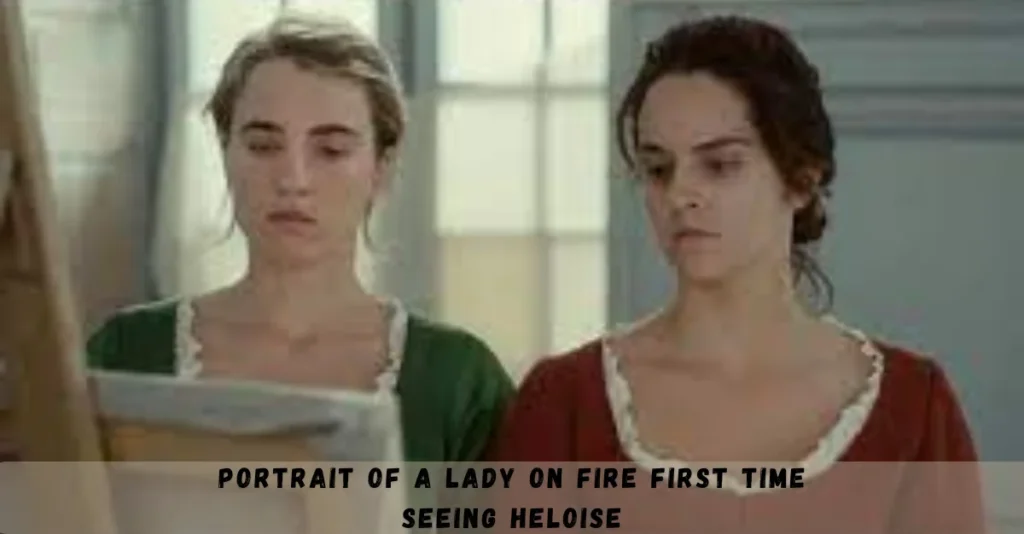Introduction to the film
“portrait of a lady on fire first time seeing heloise” captivates audiences with its stunning visuals and poignant storytelling. Set against the backdrop of 18th century France, this film explores themes of love, art, and the constraints imposed by society. One moment stands out among many: the first encounter between Héloïse and Marianne. This pivotal meeting ignites a passionate connection that transcends societal expectations.
As we delve into their initial interaction, it’s essential to understand not only who these characters are but also what their relationship signifies in a world filled with restrictions. Join us as we explore this mesmerizing film moment—one that brilliantly captures the essence of longing and desire amidst an era steeped in tradition.
Setting the scene: 18th century France
The 18th century in France was a time of elegance and upheaval. The aristocracy flaunted wealth, while the seeds of revolution began to stir among the lower classes. Streets were lined with grand châteaux and salons buzzed with intellectual discourse.
Art flourished, reflecting both beauty and societal tension. Artists captured not just portraits but emotions—moments that would soon be disrupted by change. Women navigated a world confined by strict rules yet yearned for expression beyond gilded cages.
In this backdrop of opulence juxtaposed against impending turmoil, personal connections took on profound significance. Relationships formed quietly under the weight of societal expectations, often hidden from public view.
It is here that we find Héloïse and Marianne, two souls whose paths intertwine in an extraordinary way amid whispers of love and longing against the canvas of history’s turning tides.
The character of Héloïse
Héloïse is a captivating character, embodying the complexities of desire and autonomy. Her presence in “portrait of a lady on fire first time seeing heloise” resonates with depth and nuance.
Raised in isolation, she carries an air of mystery. Each glance reveals layers of emotion—curiosity mingled with defiance.
She is not just a subject to be painted; she becomes an artist in her own right through her interactions with Marianne. Héloïse’s quiet strength challenges societal norms while also revealing vulnerability beneath her composed exterior.
Her struggle against the confines imposed by family expectations adds richness to her narrative. This tension creates a powerful backdrop for exploring love that transcends mere physical attraction.
As their story unfolds, Héloïse emerges as more than just a muse; she transforms into an equal partner navigating the intricacies of forbidden romance amidst turbulent times.
The first meeting between Héloïse and Marianne
The first meeting between Héloïse and Marianne is a moment steeped in tension and unspoken emotions. As Marianne steps into the grand yet somber manor, she is immediately struck by Héloïse’s ethereal beauty. It’s as if time stands still.
Héloïse, cloaked in silence, represents both mystery and restraint. Their eyes meet for the first time—a charged glance that carries the weight of their fates intertwined. Each woman feels an inexplicable pull toward the other.
Marianne’s role as artist blends with her burgeoning affection for Héloïse. She must capture not just her likeness but her spirit too, setting up a complex dynamic fraught with expectation.
This initial encounter lays the groundwork for their relationship—one built on curiosity yet overshadowed by societal constraints. The air is thick with possibility; they are two souls on the brink of discovery amidst an unforgiving world.
Symbolism in their initial encounter
The first meeting between Marianne and Héloïse is laden with rich symbolism. The dimly lit room sets a tone of mystery, emphasizing the hidden layers of their identities. It’s an intimate space that reflects the constraints imposed on women during this period.
Héloïse’s reluctance to be seen speaks volumes. Her covered face symbolizes the societal pressures she navigates, while her eventual gaze at Marianne reveals a spark of defiance. This moment marks not just an introduction but also a subtle rebellion against confinement.
As they share this silent exchange, nature becomes a powerful motif. The flickering candlelight mirrors the uncertainty of their budding relationship, illuminating both fear and attraction in equal measure.
Every glance holds promise yet danger, encapsulating the complexity of love constrained by societal norms. Their encounter exists in liminal space—caught between obligation and desire—a tension that defines much of their journey ahead.
The development of their relationship
As Marianne spends more time with Héloïse, their bond deepens beyond mere necessity. Initial tension gives way to genuine curiosity and understanding. Each brushstroke on the canvas becomes a silent conversation.
Héloïse’s guarded nature gradually melts away under Marianne’s attentive gaze. Their shared moments—stolen glances, whispered secrets—fuel a growing intimacy that defies societal norms.
Art plays a pivotal role in their connection. It serves as both medium and metaphor for expressing feelings unspoken by words alone. The act of painting turns into an exploration of identity, desire, and longing.
Every encounter is layered with unacknowledged passion and fear of what lies ahead. They navigate the complexities of attraction while grappling with the constraints imposed upon them by 18th-century society.
This delicate dance transforms their relationship into something profound—a beautiful yet tragic love story unfolding amidst societal expectations.
Impact of societal expectations on their love
Societal expectations loom large over Héloïse and Marianne’s budding relationship. In 18th century France, love between women is not just taboo; it’s perilous. Their connection unfolds in secrecy, shadowed by the constraints of their world.
Héloïse faces pressure to conform to her role as a dutiful bride, destined for an arranged marriage. This obligation creates tension within her heart—she yearns for freedom but feels shackled by societal norms.
Marianne, too, grapples with the weight of tradition. As an artist commissioned to paint Héloïse’s portrait, she enters a realm where personal desires clash with professional duty.
Every stolen glance carries risk; every shared moment defies convention. The very nature of their love challenges the rigid boundaries set by society, making it both beautiful and tragic—a fleeting dream that could easily shatter under scrutiny.
Conclusion and interpretation of the first encounter
The first encounter between Marianne and Héloïse in “portrait of a lady on fire first time seeing heloise” is steeped in tension and curiosity. As viewers, we witness the moment through Marianne’s eyes, capturing not just the visual beauty but also the emotional stakes involved. Their meeting takes place in an atmosphere filled with unspoken words and hidden desires.
This pivotal moment sets into motion a relationship that defies societal norms. The way they look at each other reveals layers of complexity—Héloïse’s reticence contrasts sharply with Marianne’s determined gaze. It’s a dance of discovery, where every glance holds power and potential.
Their initial interaction serves as more than just an introduction; it symbolizes their journey ahead—a love forged amidst constraints yet blooming fiercely despite them. It challenges us to reflect on how society shapes our connections while highlighting the indomitable nature of human affection.
As we ponder this iconic scene, it’s clear that it resonates far beyond its historical context. It invites us to explore themes of longing, artistry, and resistance against conformity—themes that echo within all hearts yearning for connection across barriers both seen and unseen. This first glimpse is not merely about seeing Héloïse; it marks the beginning of something profound that ultimately transcends time itself.
FAQs
What is “Portrait of a Lady on Fire first time seeing Héloïse”?
The first encounter between Héloïse and Marianne is a moment of intense, unspoken emotion, charged with curiosity and longing. It sets the foundation for their complex, passionate relationship amid societal constraints.
Why is the first meeting between Héloïse and Marianne so significant?
It marks the beginning of their emotional connection and highlights the tension between societal expectations and their growing attraction. This pivotal moment shifts their relationship from mere obligation to genuine desire.
What role does art play in the relationship between Marianne and Héloïse?
Art is a powerful medium through which Marianne expresses her feelings for Héloïse. Their bond deepens through the act of painting, which allows them to communicate their unspoken emotions and desires.
How does societal expectation affect the love story in Portrait of a Lady on Fire?
The love between Héloïse and Marianne is constrained by the societal norms of 18th-century France, where love between women is taboo. Their relationship unfolds in secrecy, heightening the tension and tragedy of their connection.
What is the symbolism in the first encounter between Marianne and Héloïse?
The dimly lit room, Héloïse’s reluctant gaze, and the flickering candlelight all symbolize the hidden, delicate nature of their connection. Their interaction reflects the tension between desire and societal repression, setting the stage for their complicated love story.







